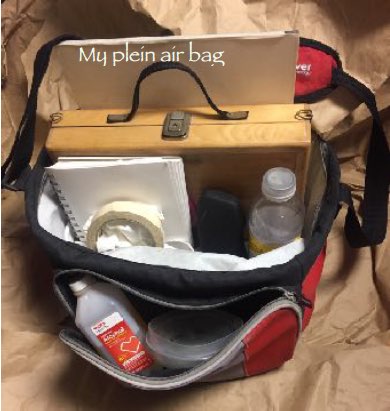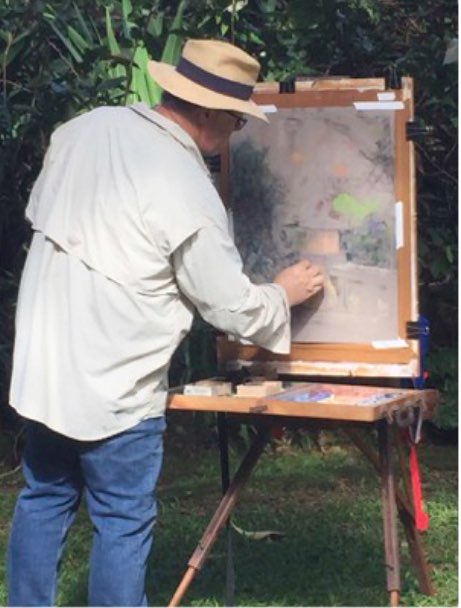Part 2: Light and Portable Painting Setups
/By PAH Member Jack Kinkelaar
I took note of a photo that Roger Tinius posted on Facebook that showed his plein air set up. He is using a number of products. He has a tripod for the base, a Heilman box with a Heilman aluminum easel connected to his tripod (you can’t see the Heilman box in this photo but you can see the metal easel which is holding his painting). On top of the Heilman box is a Dakota Blue Pastels box. Look how nice and clean his pastels are. Using this type of box cleans your pastels when you put them back into the grey foam. But Roger writes that he has tongs to pull them out of the foam so that they don’t break. That comment is enough to keep me away from this box. The Dakota box does not have the plate on the bottom so that you can connect it to a tripod. Dakota sells a wooden tripod that can hold this box. And the wooden tripod is also the easel. Go to Dakota and look it up and see if this could work for you. The Blue pastels box and a wooden easel. I think if this system falls over, most of your pastels will stay in their foam hot dog buns, or foam sushi wrappers, or foam telephone switchboard box.
Lets talk about tripods. I took a workshop with Richard McKinley a few years back. He was using a Manfrotto quick release carbon fiber tripod with a Heilman box and Heilman aluminum easel. I looked at these Manfrotto tripods but decided they were too expensive for my budget. Manfrotto has aluminum (less expensive but heavier) tripods. The point of buying the carbon fiber tripod is to keep the weight down. So I went to Amazon and bought carbon fiber tripod that was not Manfrotto. I’ve had it for 1.5 years. I use it every week and it is holding up nicely. I have to admit when I first brought it to my plein air group, I was warned to be careful about putting the legs in beach sand. The sand can get into the tubes (legs) of the tripod and mess it up. Some artists put plastic bags around the three bases of the tripod. I never did that, I just clean the sand off the bases before I fold it up. As I told you last month the idea is to keep the amount of weight down so that you can carry all of your gear at once. So I carry two things to a painting site, a bag/backback with Heilman box and a few sundry items and my tripod in its carrying case. I’m using a bag these days but when I find the right backpack I’ll make the switch. My bag holds a board with paper that goes on my easel, a sketch book with pencils, drinking water, a couple of brushes, some sheets of paper towels, masking tape, sunglasses in a case, 90% alcohol in a small bottle and a small container for using the alcohol when I’m working on my underpainting and carrot sticks for snacking. The heaviest thing is the heilman box with the pastels inside. My Heilman aluminum easel fits in the carrying case for the tripod. If there is a camera store on your island, you could go in and ask about tripods and check them out. Don't waste your time in Best Buy. When I was looking they had three tripods in stock and no one there who knew anything about them. In a camera store, they can show you the differences in weight and how the the quick-release apparatus works. If you have a pastel box with the screw hole adapter on the bottom, bring it filled with pastels to see how it feels on the various tripods. My tripod can hold up to 30 lbs.
The best thing you can do on all this equipment stuff is to talk with someone who has it. They can tell you the pluses and minuses about their choice.
Last month I posted a pic of Christine Ahia’s set up. In talking with her, she says that she wishes it was taller. I looked the easel up, it comes from Jerry’s Artarama. Its called a Feather Pro 190. Today it was listed for $39.99. Notice in the picture below that the artist is sitting and she is pretty low. You might want to listen to Christine on this. She likes it but it doesn’t go high enough.
Here is the Dakota Tripod mini field easel. It costs $105. the pastel box is separate. I think Ann Peters has this easel. Seems like it works for her. But I suggest you ask her to see what she thinks about it.
Well folks, I’m not trying to confuse you by putting too much information in this article. Just be aware that it is now February and November (and our workshop) is coming. Below is a screen shot of the tripod that I got from Amazon. I like it. I know there is probably a better one out there but I sticking with this for now. I will continue this discussion next month. My last bit of advice is that Helen Iaea has been around most of these products. You can always talk to her and get her opinion. Also, I’m not really endorsing any products.














